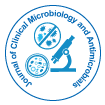
Journal of Clinical Microbiology and Antimicrobials
Open Access
+44-77-2385-9429

+44-77-2385-9429
Commentary - (2022)Volume 6, Issue 1
Bacteria are ubiquitous, mostly free-living organisms that often consist of a single biological cell. They form a large domain of prokaryotic microorganisms. Bacteria, typically a few micrometers long, were among the first life forms to appear on Earth and are present in most of its habitats. Bacteria inhabit soil, water, acidic hot springs, radioactive waste, and the deep biosphere of the Earth's crust. Bacteria are vital in many phases of the nutrient cycle by recycling nutrients such as nitrogen fixation from the atmosphere. Nutrient cycling involves the decomposition of dead bodies; bacteria are responsible for the putrefaction phase in this process. In biological communities surrounding hydrothermal vents and cold seeps, extremophilic bacteria provide the nutrients needed to sustain life by converting dissolved compounds such as hydrogen sulfide and methane into energy. Bacteria also live in symbiotic and parasitic relationships with plants and animals. Most bacteria have not been characterized and there are many species that cannot be grown in the laboratory. The study of bacteria is known as bacteriology, the branch of microbiology.
Bacteria are ubiquitous and live in every conceivable location on the planet, including soil, underwater, deep in the Earth's crust, and even in such extreme environments as acidic hot springs and radioactive waste. There are approximately 2 × 1030 bacteria on Earth that make up the biomass, which is exceeded only by plants. They are abundant in lakes and oceans, arctic ice and geothermal springs, where they provide the nutrients needed to sustain life by converting dissolved compounds such as hydrogen sulfide and methane into energy. They live on and in plants and animals. Most of them do not cause diseases, are beneficial to their environment and are necessary for life. Soil is a rich source of bacteria, and a few grams contain around a thousand million of them. All are essential to soil ecology, breaking down toxic waste and recycling nutrients. They are even found in the atmosphere, and one cubic meter of air can hold around one hundred million bacterial cells. Oceans and seas contain approximately 3 × 1026 bacteria, which provide up to 50% of the oxygen humans breathe. Only about 2% of bacterial species have been fully studied.
Classification
Classification seeks to describe the diversity of bacterial species by naming and grouping organisms based on similarities. Bacteria can be classified based on cellular structure, cellular metabolism, or differences in cellular components such as DNA, fatty acids, pigments, antigens, and quinones. While these schemes allowed the identification and classification of bacterial strains, it was unclear whether these differences represented variation between different species or between strains of the same species. This uncertainty has been due to the lack of characteristic structures in most bacteria, as well as lateral gene transfer between unrelated species. As a result of lateral gene transfer, some closely related bacteria can have very different morphology and metabolism. To overcome this uncertainty, modern bacterial classification emphasizes molecular systematics using genetic techniques such as guanine-cytosine ratio determination, genome-genome hybridization, as well as sequencing genes that have not undergone extensive lateral gene transfer, such as the rRNA gene. Classification of bacteria is determined by publication in the International Journal of Systematic Bacteriology and Bergey's Manual of Systematic Bacteriology. The International Committee on Systematic Bacteriology (ICSB) maintains international rules for naming bacteria and taxonomic categories and for their order in the International Code of Bacterial Nomenclature.
Historically, bacteria were considered part of Plantae, the plant kingdom, and were called "Schizomycetes" (fission fungi). For this reason, the common bacteria and other microorganisms in the host are often called "flora". The term "bacteria" has traditionally been applied to all microscopic unicellular prokaryotes. However, molecular systematics has shown that prokaryotic life consists of two separate domains, originally called Eubacteria and Archaebacteria but now called Bacteria and Archaea, which evolved independently from ancient common ancestors. Archaea and eukaryota are more closely related to each other than both are to bacteria. Together with Eukarya, these two domains form the basis of the three-domain system, which is currently the most widely used classification system in microbiology. However, due to the relatively recent introduction of molecular systematics and the rapid increase in the number of available genome sequences, bacterial classification remains a changing and expanding field. For example, Cavalier- Smith argued that Archaea and Eukaryota evolved from Grampositive bacteria.
Types
There are many different types of bacteria. One way to classify them is by shape. There are three basic shapes.
Spherical: Spherical bacteria are called cocci and one bacterium is a coccus. Examples include the streptococcal group, which is responsible for "streptococci".
Rod-shaped: These are known as bacilli (singular bacillus). Some rod-shaped bacteria are curved. These are known as vibrio. Examples of rod-shaped bacteria include Bacillus anthracis (B. anthracis) or anthrax.
Spiral: They are known as spirilla (singular spirillus). If their coil is very tight, they are known as spirochetes. Bacteria of this shape cause leptospirosis, Lyme disease and syphilis.
There are many variations within each shape group.
Citation: Fim V (2022) Bacterial Habitat, its Classification and Types. J Clin Microbiol Antimicrob. 06: 130
Received: 15-Mar-2022, Manuscript No. JCMA-22-20196; Editor assigned: 17-Mar-2022, Pre QC No. JCMA-22-20196 (PQ); Reviewed: 01-Apr-2022, QC No. JCMA-22-20196; Revised: 07-Apr-2022, Manuscript No. JCMA-22-20196 (R); Published: 15-Apr-2022 , DOI: 10.35248/JCMA. 22.6.130
Copyright: © 2022 Fim V. This is an open-access article distributed under the terms of the Creative Commons Attribution License, which permits unrestricted use, distribution, and reproduction in any medium, provided the original author and source are credited.